Marrying Vega and Zen: The AMD Ryzen 5 2400G Review
by Ian Cutress on February 12, 2018 9:00 AM ESTBenchmarking Performance: CPU Rendering Tests
Rendering tests are a long-time favorite of reviewers and benchmarkers, as the code used by rendering packages is usually highly optimized to squeeze every little bit of performance out. Sometimes rendering programs end up being heavily memory dependent as well - when you have that many threads flying about with a ton of data, having low latency memory can be key to everything. Here we take a few of the usual rendering packages under Windows 10, as well as a few new interesting benchmarks.
All of our benchmark results can also be found in our benchmark engine, Bench.
Corona 1.3: link
Corona is a standalone package designed to assist software like 3ds Max and Maya with photorealism via ray tracing. It's simple - shoot rays, get pixels. OK, it's more complicated than that, but the benchmark renders a fixed scene six times and offers results in terms of time and rays per second. The official benchmark tables list user submitted results in terms of time, however I feel rays per second is a better metric (in general, scores where higher is better seem to be easier to explain anyway). Corona likes to pile on the threads, so the results end up being very staggered based on thread count.

Blender 2.78: link
For a render that has been around for what seems like ages, Blender is still a highly popular tool. We managed to wrap up a standard workload into the February 5 nightly build of Blender and measure the time it takes to render the first frame of the scene. Being one of the bigger open source tools out there, it means both AMD and Intel work actively to help improve the codebase, for better or for worse on their own/each other's microarchitecture.
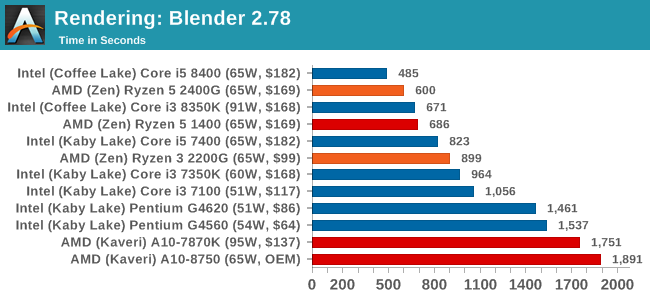
LuxMark v3.1: Link
As a synthetic, LuxMark might come across as somewhat arbitrary as a renderer, given that it's mainly used to test GPUs, but it does offer both an OpenCL and a standard C++ mode. In this instance, aside from seeing the comparison in each coding mode for cores and IPC, we also get to see the difference in performance moving from a C++ based code-stack to an OpenCL one with a CPU as the main host.
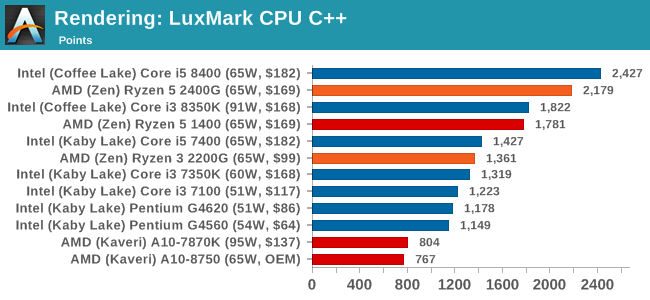
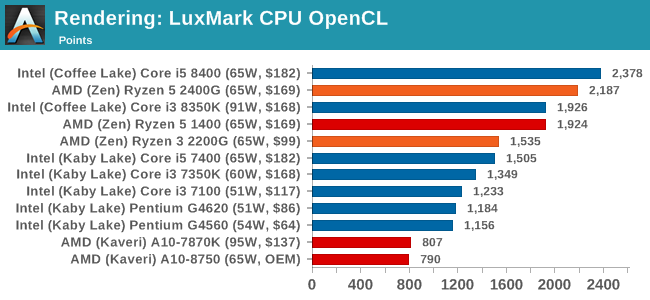
POV-Ray 3.7.1b4: link
Another regular benchmark in most suites, POV-Ray is another ray-tracer but has been around for many years. It just so happens that during the run up to AMD's Ryzen launch, the code base started to get active again with developers making changes to the code and pushing out updates. Our version and benchmarking started just before that was happening, but given time we will see where the POV-Ray code ends up and adjust in due course.
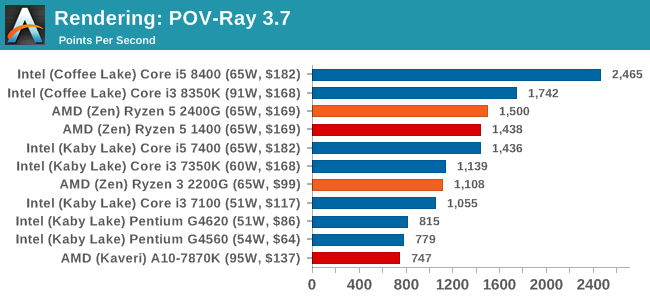
Cinebench R15: link
The latest version of CineBench has also become one of those 'used everywhere' benchmarks, particularly as an indicator of single thread performance. High IPC and high frequency gives performance in ST, whereas having good scaling and many cores is where the MT test wins out.
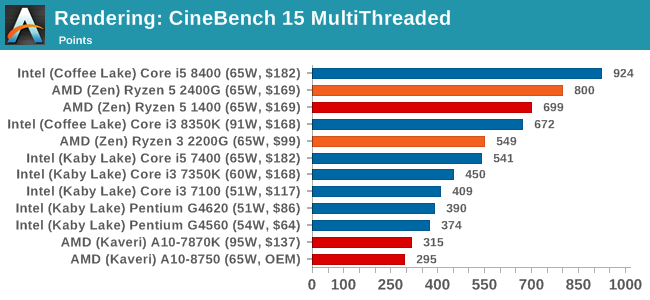

Conclusions on Rendering: It is clear from these graphs that most rendering tools require full cores, rather than multiple threads, to get best performance. The exception is Cinebench.










177 Comments
View All Comments
Lolimaster - Monday, February 12, 2018 - link
You don't another model, just disable high clocked pstates till you get the power consumption you want.I can lock my Athlon II X4 to 800Mhz if I desire.
Lolimaster - Monday, February 12, 2018 - link
You can simply set pstate for a lower base clock and also undervolt if you want to reduce power consupmtion even more.Or the lazy way, cTDP in bios to 45w.
Manch - Tuesday, February 13, 2018 - link
Ask and ye shall receivehttps://www.anandtech.com/show/12428/amd-readies-r...
Cryio - Monday, February 12, 2018 - link
This review kind of confused me?It mentioned it's going to compare the A12 9800, but this APU is nowhere to be seen in benchmarks.
Then out of nowhere come A10 7870K, which is fine I guess, but then there's the A10 8750, which doesn't exit, I can asume it's 7850, yet a 7850 non K APU doesn't exist, so what's happening here?
Simon_Says - Monday, February 12, 2018 - link
Will there be any analysis on current and potential future HTPC performance? While it won't support Netflix 4k or UHDBR (yet, thanks Playready 3.0) I for one would still like to know how it handles HDR for local media playback and Youtube, and if it will have the CPU grunt to software decode AV1.Drazick - Monday, February 12, 2018 - link
Does the Ryzen have any hardware based unit for Video trans coding?Could you test that as well (Speed and Quality).
It will be interesting as this CPU can be heaven for HTPC and for NAS with Multimedia capabilities.
Thank You.
GreenReaper - Wednesday, February 14, 2018 - link
It is meant to support up to 4K H.264/5 at 30/60/120FPS for 4K/1440p/1080p resolutions. Obviously it'd be nice to see people testing this out, and the quality of the resulting video.gerz1219 - Monday, February 12, 2018 - link
Still not quite getting the point of this product. Back when it made sense to build an HTPC, I liked the idea of the Bulldozer-era APU, so that I could play games on the TV without having a noisy gaming rig in the living room. But the performance is just never quite there, and it looks like it will be some time before you can spend ~$400 and get 4K gaming in the living room. So why not just buy an Xbox One X or PS4? I also bought a Shield TV recently for $200 and that streams games from my VR/4K rig just fine onto the TV. I'm just not seeing the need for a budget product that's struggling at 1080p and costs about the same as a 4K console.jjj - Monday, February 12, 2018 - link
There are 7+ billion people on this planet and the vast majority of them will never be able to afford a console or to pay a single cent for software - consoles are cheap because they screw you on the software side.Vs the global average you are swimming in money.
And ofc the majority of the PC market is commercial as consumer has been declining hard this decade.
Most humans can barely put food on the table, if that and even a 200$ TV is a huge investment they can afford once every 15 years.
Pinn - Monday, February 12, 2018 - link
But $10 per day on cigarettes is fine?